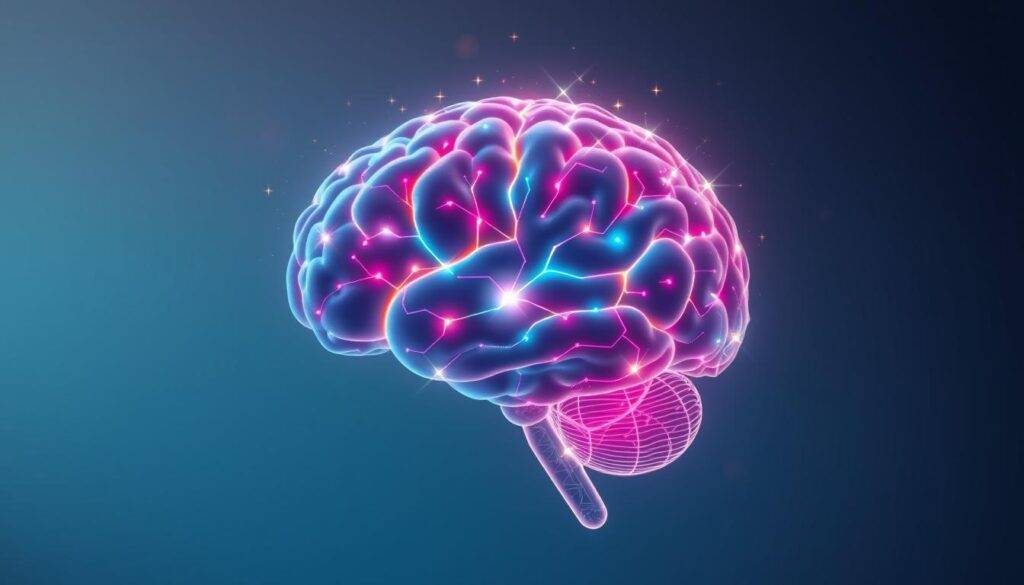“The mind is everything. What you think, you become.” – Buddha
Your brain can change and form new connections at any age. This is called neuroplasticity. It lets you change your thoughts, habits, and mindset for success. Positive affirmations are key to this change. They are powerful statements that can change your brain and help you grow.
We will dive into the science of neuroplasticity and how affirmations affect your brain and life. You’ll learn how to use your mind to make lasting changes. You’ll also find out how to beat negative patterns and build a success mindset.
Key Takeaways
- Neuroplasticity allows your brain to form new connections and adapt to new experiences, enabling personal growth.
- Positive affirmations can rewire your brain by strengthening neural pathways linked to success and positivity.
- Consistent affirmation practice can foster a more optimistic mindset, increased happiness, and better subjective health.
- Combining affirmations with visualization and goal-setting can amplify the effects of neuroplasticity and manifest tangible results.
- Maintaining a daily affirmation routine is key to creating sustainable changes in your thoughts, behaviors, and overall well-being.
Understanding the Power of Neural Plasticity in Personal Development
Your brain has a special ability called neural plasticity. It lets your brain change and adapt as you live. This ability is key to growing and changing in lasting ways. Learning about neural plasticity can help you change your life in big ways.
The Science Behind Brain Adaptability
Neural plasticity is about your brain making new connections and changing old ones. This happens because of what you learn and experience. It’s like a rule: “Cells that fire together, wire together.”
When you do something over and over, your brain gets better at it. This makes it easier to do it again. But if you don’t use certain pathways, they can get weaker.
How Neural Pathways Form and Change
Creating and changing neural pathways is important for learning and changing. When you do something new, your brain gets stronger at it. But if you ignore certain pathways, they can weaken.
The Role of Neuroplasticity in Behavior Change
Knowing about neuroplasticity is key to personal growth. By choosing what you think and do, you can change your brain. This lets you break free from old habits and reach your full potential.
| Neuroplasticity Principles | Application in Personal Development |
|---|---|
| Neural pathways form and strengthen through repeated activation | Regularly practice positive affirmations and visualizations to reinforce desired behaviors |
| The brain can adapt and change at any age | Engage in lifelong learning and challenging activities to stimulate cognitive flexibility |
| Sensory input and environmental enrichment shape neural connections | Surround yourself with positive influences and experiences that support your goals |
By using neural plasticity, you can change your brain for the better. This opens up a world of personal growth and development.

The Foundation of Positive Affirmations in Brain Training
Positive affirmations come from positive psychology and cognitive-behavioral therapy. They help fight self-doubt and negative thoughts. Studies show they change brain chemistry for the better.
Affirmations boost dopamine and serotonin, which help us feel good. This makes us want to repeat them. It also lowers stress and builds confidence.
Using affirmations can make you feel more confident. It helps you face challenges head-on. It also makes you believe you can grow and learn more.
Affirmations also help reduce stress and anxiety. They bring calm in tough times. They improve focus and help set goals by aligning thoughts with actions.
They help you see obstacles as chances to grow. Being optimistic lets you find solutions to problems.
The subconscious mind runs old programs we’ve taught it. But repetition can change it. Affirmations help create a positive mindset by repeating them often.
“Affirmations are just one of many methods available to rewire the brain, alongside meditation, visualization, gratitude practices, journaling, and mindfulness.”
Research shows believing in yourself changes your brain. It can lead to success. Feeling confident boosts dopamine, improving focus and decisions. A positive self-view also lowers stress, making challenges seem less scary.

Positive affirmations are key to self-empowerment and brain training. By using them regularly, you can reach your full potential and change your mind for success.
Neuroplasticity and Affirmations: How to Rewire Your Brain for Success
Our thoughts shape our brain’s pathways, key to success. Positive affirmations help create growth and achievement. They target self-doubt and low self-esteem.
The Connection Between Thoughts and Neural Pathways
Our thoughts shape our brain’s pathways. Repeated thoughts strengthen connections. New thoughts create new paths.
Creating New Mental Patterns Through Affirmations
Affirmations use the brain’s ability to change. They build confidence and achievement. This helps overcome doubts and grow.
Measuring Success in Brain Rewiring
Success in rewiring shows in behavior and emotions. Mindset shifts are also signs. Be patient and stay consistent.
| Indicator | Observed Changes |
|---|---|
| Behavior | – Increased motivation and goal-oriented actions – Improved decision-making and problem-solving skills – Healthier coping mechanisms during challenges |
| Emotional Response | – Decreased levels of stress, anxiety, and negative emotions – Enhanced feelings of confidence, optimism, and inner peace |
| Mindset Shift | – Embracing a growth mindset and seeing challenges as opportunities – Increased self-belief and belief in personal capabilities – Focusing on solutions rather than problems |
“By consistently repeating positive statements, individuals can strengthen neural connections associated with success-oriented thinking.”
Breaking Negative Thought Patterns Through Self-Affirmation
Negative thoughts can stop you from reaching your goals. But, the brain can change and adapt. By choosing positive affirmations and repeating them, you can change your brain for the better.
Self-affirmation helps a lot. It weakens old, bad habits and strengthens new, good ones. By changing your inner talk to positive self-talk, you open up new possibilities.
Doing self-affirmation regularly can really boost your self-esteem and mental health. Try keeping a gratitude journal, use visualization, and do cognitive restructuring to make your efforts even stronger.
“The greatest weapon against stress is our ability to choose one thought over another.” – William James
Start using the power of neuroplasticity for self-affirmation. By focusing on positive thoughts, you can overcome old beliefs and grow personally.
The Science of Habit Formation and Neural Restructuring
Habit formation is a complex mix of our actions and brain adaptability. The habit loop, with its cue, routine, and reward, is key to forming new habits. As we repeat this loop, our brain’s pathways get stronger, making the habit stick. Knowing how habits change in our brain is vital for success.
Understanding the Habit Loop
The habit loop is a pattern in our brain that guides our actions. It starts with a cue, then a routine, and ends with a reward. This cycle becomes automatic over time. By understanding the habit loop, we can change our habits.
Neurological Basis of Habit Change
To change habits, we need to rewire our brain. Breaking old pathways and creating new ones helps our brain adapt. This process, called neural plasticity, lets us change our brain for the better. It’s about weakening old connections and strengthening new ones.
Time Requirements for Neural Rewiring
Changing our brain takes time and effort. Studies show changes can happen in 21 to 66 days with consistent practice. But, the time can vary based on the habit’s complexity and our brain’s makeup. By staying patient and celebrating small victories, we can build lasting habits.
“The greatest weapon against stress is our ability to choose one thought over another.” – William James
Creating Effective Personal Affirmations for Brain Optimization
Unlocking the power of personal affirmations is a journey to brain optimization and self-empowerment. These positive statements can change your mind and life. By making affirmations that match your goals, you build confidence and personal growth.
Understanding how thoughts and brain work is key. Neuroplasticity lets your brain change and grow. Repeating positive affirmations shapes your brain for success.
To make good affirmations, target areas of doubt. Use action words and feeling words for power. Make them specific, positive, and present, like “I am confident in achieving my goals.”
Consistency and feeling are crucial for brain optimization. Use affirmations daily in your routine. This aligns your thoughts, feelings, and actions, showing the power of positive self-talk and brain optimization.
“Affirmations are our mental vitamins, providing the supplementary positive thoughts we need to balance the barrage of negative events and thoughts we experience daily.” – Tia Walker
Start your journey of self-discovery with personal affirmations. With commitment and a growth mindset, you’ll see amazing changes in your brain and life.
Implementing Daily Affirmation Practices for Maximum Impact
Adding daily affirmations to your morning can make a big difference. Both written and spoken affirmations work well. Hearing yourself say them might be especially effective.
Morning Routine Integration
Begin by thinking about your goals and values. Use affirmations in your meditation or write them in a journal. Use phone reminders or sticky notes to stay on track.
Written vs. Spoken Affirmations
- Written affirmations help you connect deeply with the words.
- Spoken affirmations, especially your own voice, can have a strong effect.
Tracking Progress and Adjusting Methods
Sticking to affirmations is important. Keep a journal to see how you’ve changed. Change your affirmations as your goals change. Even a few minutes a day can make a big difference.
“Self-affirmation activities can lead to decreased stress levels, improved well-being, academic performance enhancement, and increased willingness for behavior changes.”
Daily affirmations in your morning routine can change your brain for the better. Try both written and spoken affirmations. Keep track of your progress to stay motivated and adjust as needed.
Combining Visualization with Affirmations for Enhanced Results
Using visualization techniques and positive affirmations together can change your brain for the better. Visualization makes your brain think the goal is already real. Affirmations then boost the positive thoughts linked to that success. This mix makes your goals seem closer and increases your drive to achieve them.
To make this combo work best, add lots of sensory details to your visualizations. Don’t just see the end result; picture the whole journey to get there. Think about the feelings, sights, sounds, and smells as you move towards your goals. This multi-sensory method makes the outcome feel real and within reach.
Adding mental imagery to your affirmations can really help you get past hurdles and believe in yourself. As you see yourself overcoming obstacles, say affirmations that show your strength and ability. This mix can change your brain’s focus to success, not fear or doubt.
“When you visualize, and then focus all your energy on creating what you visualized, you can manifest your deepest desires.” – Shakti Gawain
Adding this affirmation enhancement to your daily life can be a big change for goal achievement. It doesn’t matter if you’re trying to start a new habit, beat a negative belief, or bring your biggest dreams to life. The mix of visualization and affirmations can rewire your brain for success.
Understanding the Role of Consistency in Neural Reprogramming
To see real change through neural reprogramming, you must be consistent. Consistent practice is key to creating and strengthening new neural paths. This leads to lasting changes in your thoughts, feelings, and actions.
Building Sustainable Practice Routines
Begin by setting achievable goals for your neural reprogramming practice. Make affirmations a part of your daily life, like morning routines, mid-day breaks, or evening reflections. As you get better, make your practice more challenging and longer.
Overcoming Common Obstacles
- Lack of time: Make time for affirmations, even if it’s just a few minutes.
- Skepticism: Learn about the science behind affirmations and neuroplasticity to trust the process.
- Impatience: Remember, neural reprogramming takes time. Celebrate every small win.
Consistency is crucial for affirmations to work their magic in brain rewiring. With steady effort and a long view, you can shape your brain and unlock the power of positive thinking.
“Consistent practice is the key to unlocking the transformative power of affirmations in neural reprogramming.”
| Consistency Strategies | Benefits |
|---|---|
| Integrating affirmations into daily routines | Reinforces new neural pathways through repetition |
| Gradually increasing practice complexity | Challenges the brain to adapt and grow |
| Overcoming obstacles with patience and determination | Develops resilience and long-term commitment |
Measuring Progress: Signs Your Brain Is Rewiring
Starting your brain rewiring journey with positive affirmations is exciting. It’s important to know the signs that show your brain is changing. These signs will keep you motivated and help you improve your affirmations.
One early sign is self-awareness. You might notice you’re more aware of your thoughts and feelings. This lets you make better choices.
Another sign is emotional regulation. You’ll feel more in control of your emotions, especially when things get tough.
Seeing stress resilience improve is a big win. You’ll bounce back faster from hard times and stay positive. Your habitual reactions will also start to change as your brain adapts.
Changes in decision-making are another sign. You’ll think more before acting, considering different views. This leads to choices that match your values and goals.
Finally, a positive outlook on life shows your brain is rewiring well. You’ll start to see the good in things and believe in possibilities.
To track your progress, keep a journal. Write down how your thoughts, confidence, and handling of challenges change. Remember, rewiring your brain takes time, but the results are worth it.
“Positive affirmations can have a profound impact on our neural pathways, rewiring our brains for success and well-being.” – Dr. Smith, Psychologist
| Sign of Brain Rewiring | Description |
|---|---|
| Increased Self-Awareness | Greater mindfulness of thoughts, emotions, and reactions |
| Improved Emotional Regulation | Better control over emotional responses, especially in challenging situations |
| Enhanced Resilience to Stress | Ability to bounce back from setbacks and maintain a positive outlook |
| Changes in Habitual Reactions | Transformation of knee-jerk responses as new neural pathways form |
| Shifts in Decision-Making | More thoughtful consideration of options and alignment with values |
| Positive Outlook on Life | Increased optimism and belief in possibilities |
Tools and Resources for Neural Reprogramming Success
Changing your brain and growing personally doesn’t have to be alone. Many tools and resources help with neural reprogramming. They make the journey more fun and effective.
Digital Applications and Platforms
Apps like ThinkUp are designed to boost your affirmation practice. They let you record your voice and add music. This helps create new brain paths and keeps you motivated.
There are many affirmation apps out there. Add them to your daily routine for better results.
Journaling Techniques and Templates
Journaling is a great way to support neural reprogramming. Tools like The MindBody Workbook guide you in writing down your thoughts and feelings. It’s important to focus on positive experiences and growth.
Don’t write only about negative things. Instead, write about what you’re grateful for and your personal growth. Use digital reminders and journaling to improve your brain and self.
FAQ
What is neuroplasticity and how does it relate to personal development?
Neuroplasticity lets the brain change and adapt throughout life. It’s about making new connections based on what we experience. This flexibility helps us learn new things and change our behavior.
How do positive affirmations work to rewire the brain?
Positive affirmations use positive psychology and cognitive-behavioral therapy. They change the brain’s pathways, leading to positive thoughts. This process boosts mood by releasing dopamine and serotonin.
How can I create effective personal affirmations for brain optimization?
Make affirmations personal and specific to your goals. They should be positive and in the present tense. Use action and feeling words to make them more powerful.
How do I implement a daily affirmation practice for maximum impact?
Start your day with affirmations to set a positive tone. Written or spoken affirmations work well. Consistency is key, and journaling about progress helps.
How can I combine visualization techniques with affirmations for enhanced results?
Visualization makes goals feel closer by activating brain pathways. Imagine success while saying affirmations. This strengthens neural connections and boosts motivation.
What are the signs that my brain is successfully rewiring through consistent practice?
Look for increased self-awareness and better emotional control. Notice changes in how you react and make decisions. Positive self-talk and confidence in goals are signs of progress.
What tools and resources can support my neural reprogramming efforts?
Tools like ThinkUp help with recording affirmations and music. Journaling, especially with guides like The MindBody Workbook, is also helpful. Use a mix of digital reminders, written affirmations, and journaling for a full approach.




























































